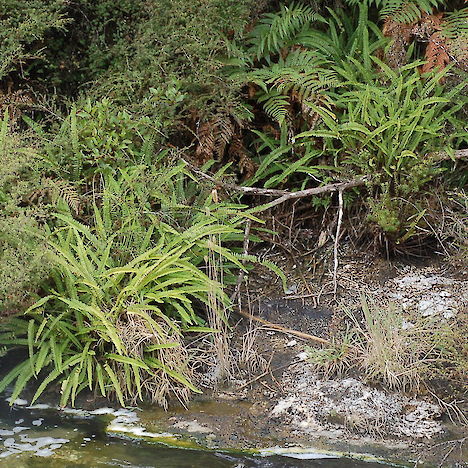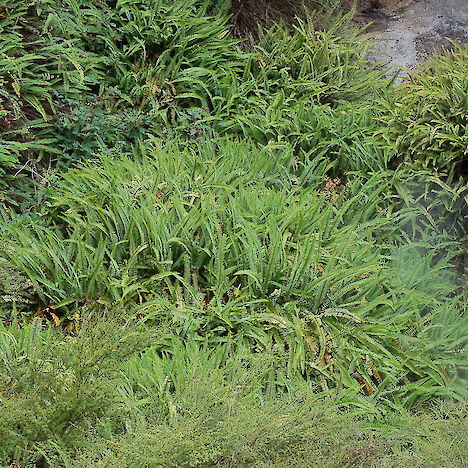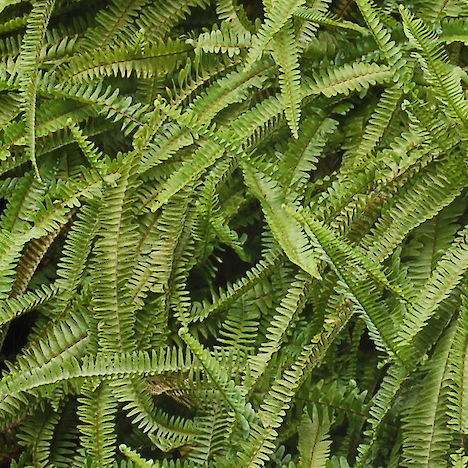Threat category:
At Risk: Naturally Uncommon?Regions:
Waikato, Bay of PlentyDistribution:
North Island, in geothermal sites between Kawerau and Lake Taupō
Key Features
- Nephrolepis flexuosa is a terrestrial fern with short, erect rhizomes (underground stems) and stolons (lateral shoot) without tubers.
- In New Zealand, it is most likely to be confused with the exotic tuber sword fern (Nephrolepis cordifolia), where both species occur together as they do at some geothermal sites e.g. near Kawerau.
- N. flexuosa tends to have narrower, more gracile fronds which are typically drooping, while those in N. cordifolia are wider, stouter and invariably rigidly erect.
Distribution and Habitat
- This indigenous species is known with certainty from New Zealand, Raoul, Norfolk and Lord Howe Islands, and also Fiji and Rarotonga.
- It may also be present in Samoa and Sri Lanka, and it is probably wide ranging throughout the Indian and Pacific Oceans. It may also be in Australia.
- Nephrolepis flexuosa is abundant in coastal forest and scrub on Raoul Island, otherwise in New Zealand it is confined to the North Island where it is only known from 17 active geothermal sites between Kawerau and Lake Taupō.
- Its main habitats within geothermal sites are banks alongside stream margins, steam vents, and geothermally heated soils in scrub, shrubland, and fernland. It occasionally grows on sinter margins.
- It may reach a world southern limit at Tokaanu near Turangi (NZPCN website).
Threats
- Habitat modification and loss, particularly conversion of natural habitats to other land uses and drainage of geothermal wetlands. Geothermal habitat may also be lost due to energy extraction.
- Some populations are very small and are therefore vulnerable to extinction. However, other populations are relatively large and are not threatened if geothermal systems and associated vegetation are protected.
- Pest plant invasion, particularly blackberry on geothermal and riparian margins.
- Some small populations have established in disturbed parts of sites and may not survive if vegetation succeeds into other types.
- Potentially introduced weeds tolerant of heated soils.
- Competition with tuber sword fern, which differs in having tubers and wider, stouter and more rigid fronds. It can be difficult to differentiate in the field, which can make control of this species difficult at sites where both species are present.
- Spread of blackberry (Rubus fruticosus agg.) and other weeds.
Management Opportunities
- Check existing populations on a regular basis, either by direct monitoring or photopoints.
- Weed control.
- Protection of habitat.
- Ensure that forest owners are aware of potential habitats and can recognise the species.
- Undertake surveys of geothermal areas to identify the values present and provide information to landowners.
Monitoring Options
- Check existing populations annually.
- Report new locations to DOC.
Further Information and Support
- Weed control - Department of Conservation, Regional Councils.
References
- Brownsey P.J. & Smith-Dodsworth J.C. (2000). New Zealand Ferns and Allied Plants. David Bateman, Auckland.
- de Lange P.J., Gardner R.O., Sykes W.R., Crowcroft G.M., Cameron E.K., Stalker F., Christian M.L., and Braggins J.E. (2005). Vascular flora of Norfolk Island: some additions and taxonomic notes. New Zealand Journal of Botany 43: 563-596.
- de Lange (2005). Nephrolepis flexusoa - Fact Sheet by P.J. de Lange 7 December 2005. Description based on Brownsey and Dodsworth (2000) supplemented with observations made from herbarium. New Zealand Plant Conservation Network. http://www.nzpcn.org.nz/flora_details.aspx?ID=785: Accessed 7 March 2019.





